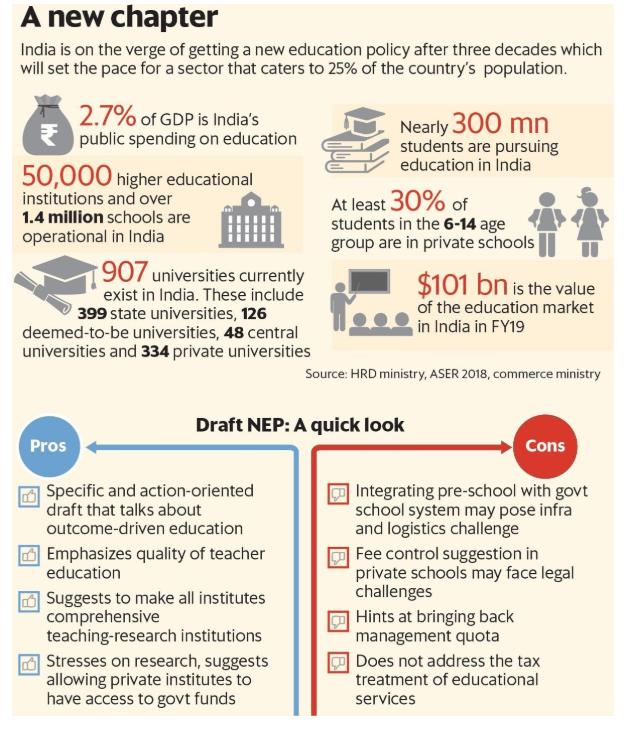The Big Picture- RSTV
Draft National Education Policy – 3 Language Formula
Archives
TOPIC: General Studies 2
- Government policies and interventions for development in various sectors and issues arising out of their design and implementation.
- Issues relating to development and management of Social Sector/Services relating to Education
In News: Facing pressure from Tamil Nadu against the draft National Education Policy’s recommendation for teaching Hindi in all the States, the Union government has issued a modified draft leaving out a controversial clause.
- In the modified draft uploaded by the Human Resource Development Ministry, a Section, titled ‘Flexibility in the choice of languages’ has been changed, omitting any reference to ‘which’ languages students may choose. There is no mention of Hindi in the clause.
- The revised policy requires proficiency in any three languages. The earlier draft education policy triggered outrage in southern states, led by Tamil Nadu, which said they will not tolerate Hindi imposition in the state that doesn’t speak the language.
- In the previous version of the draft policy, English and Hindi were proposed as mandatory languages in non-Hindi speaking states while a third language was mandatory in Hindi-speaking states.
The formula, the opposition
The three-language formula, dating back to 1968, means students in Hindi-speaking states should learn a modern Indian language, apart from Hindi and English and, in non-Hindi-speaking states, Hindi along with the regional language and English.
What is the formula?
It is commonly understood that the three languages referred to are Hindi, English and the regional language of the respective States. Though the teaching of Hindi across the country was part of a long-standing system, it was crystallised into a policy in an official document only in the National Policy on Education, 1968. This document said regional languages were already in use as the media of education in the primary and secondary stages. In addition, it said, “At the secondary stage, State governments should adopt and vigorously implement the three-language formula, which includes the study of a modern Indian language, preferably one of the southern languages, apart from Hindi and English in the Hindi-speaking States.” In the ‘non-Hindi speaking States’, Hindi should be studied along with the regional language and English. It added: “Suitable courses in Hindi and/or English should also be available in universities and colleges with a view to improving the proficiency of students in these languages up to the prescribed university standards.”
What is the backdrop to the Hindi imposition row?
The State has been traditionally opposed to any attempt to introduce Hindi as a compulsory language of learning or administration. The origin of the linguistic row, however, goes back to the debate on official language. In the Constituent Assembly, Hindi was voted as the official language by a single vote. However, it added that English would continue to be used as an associate official language for 15 years. The Official Languages Act came into effect on the expiry of this 15-year period in 1965. This was the background in which the anti-Hindi agitation took place. However, as early as in 1959, Jawaharlal Nehru had given an assurance in Parliament that English would continue to be in use as long as non-Hindi speaking people wanted it.
The Liguistic Inequality we saw
The three-language formula was a prudent way to resolve the vexed issue of English and the various modern Indian languages, or bhashas. It respected the primacy of the state/regional languages, while recognising the emerging utility of Hindi as a bridge among Indian languages and that of English as a bridge to the world outside India. Sadly, the formula was never practiced in its true spirit. The Hindi belt states found ways to circumvent it.
Instead of getting Hindi-speaking children to learn, say Tamil or Marathi or Bengali, they started using perfunctory teaching of Sanskrit (or, in a few cases Urdu) to meet the formality of the third language. So, in reality, the three-language formula meant that non-Hindi-speakers learnt Hindi while Hindi speakers learnt no other modern Indian language. This inequality has naturally caused heartburn.
DNPE – The Step that was most awaited, because …
- First, it recommends multilingualism as the foundation of education in a country like ours, thus moving away from a pointless debate about what should be the national language. It recognises children’s ability to learn several languages and the cognitive advantages of multilingual education.
- Second, like the previous policy documents, it reiterates the well-known pedagogic wisdom, supported by cognitive psychology, that the child’s “home language” or “mother tongue” must be her medium of instruction. This is in sharp contrast to the cognitive barbarity of the spread of English as a medium of instruction in a setting where, more often than not, the child, the parents, as well as the teachers, are innocent of this language.
- Third, it celebrates the strength of Indian languages as carriers of modern education and the country’s future. It makes a strong case for teaching of and knowledge creation in these languages. The government would do well to implement the detailed suggestions for helping the growth, preservation and vibrancy of Indian languages.
- Fourth, and conversely, it attests to the fact that the dominance of English language is due less to its intrinsic value and more because it is the language of the dominant elite. I call the prevailing situation a system of linguistic apartheid. The DNPE makes bold to say something that needed to be said: dominance of English needs to end.
Note:
- Education falls under the Constitution’s concurrent list of subjects that can be legislated upon by both the Centre and states.
- National Education Policy

Connecting the Dots:
- Is the DNPE a step forward in policy thinking on the issue of language and education? Examine.














